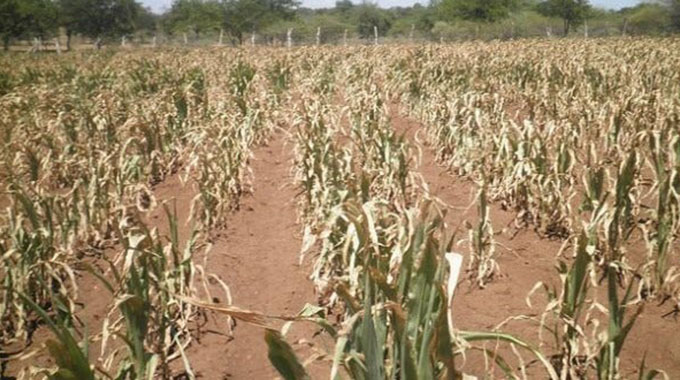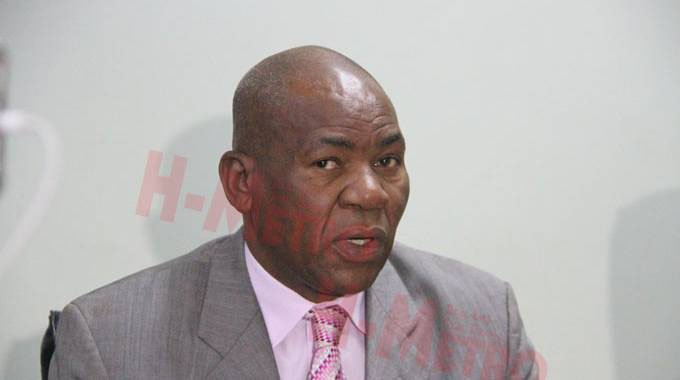Experts warn of another drought

Sifelani Tsiko Agriculture, Environment & Innovations Editor
Farmers in southern Africa should from this year, adapt and plant drought-resistant crops, concentrate on short season varieties and rear drought-tolerant livestock breeds as the frequency of droughts intensifies. Farmers should also be encouraged to grow traditional crops that are more drought-resistant and adaptable to climate change.
Hybrid varieties of both livestock and crops as well as long season varieties should be the preserve of those with irrigation.
Zimbabwe and most other SADC countries should step up efforts to harness water from dams and other sources to promote irrigation and enhance water supply to the region’s rapidly urbanising population.
In addition, governments across the region need to urgently plan to mobilise humanitarian assistance to support food requirements of the vulnerable populations.
This comes as southern Africa — which is in the grip of a crippling drought — is set to experience another severe round of drought in the 2019–2020 cropping season, worsening the food security situation which has left millions in need of food assistance, The Herald can reveal.
According to the latest Global Agricultural Geo-monitoring Initiative (GEOGLAM) special report on the Southern Africa 2019 -2020 cropping season, the entire Southern African region is forecast to receive below-average rainfall that may affect crops and reduce yields sharply.
The GEOGLAM forecast, to some extent, contradicts the SADC regional rainfall forecast for the 2019-2020 cropping season which predicted that most SADC countries were likely to receive normal to above normal rainfall.
Predictions issued by climate experts at the 23rd Southern African Regional Climate Outlook Forum (SACORF-13), which was held in Angola in September, indicate that the bulk of SADC is likely to receive normal to above normal rainfall for most of the period October to December (OND) 2019.
GEOGLAM, a Geneva-based satellite monitoring observation system, said the rainfall pattern will worsen the region’s food security position following last year’s drought which ravaged the entire sub-continent.
“The latest seasonal forecast models indicate below – normal December to February (DJF) rainfall across the southern half of the region, spanning from southern Zambia to Namibia and south through South Africa,” read part of the report.
“Persistent drier than normal conditions during this DJF period may affect crop establishment and suppress crop yields.”
Planting in Zimbabwe and most other SADC countries was already underway for the 2019 – 20 summer crop.
The region’s rainfall season usually runs from around mid-October through to March the following year.
The report indicated that rainfall received so far in the Southern Africa region has been below average across a number of countries.
“Areas forecast to receive below – average rainfall include those areas impacted by the 2018 -19 drought. Food security and access will be of increasing concern if forecast below-average rains materialize,” GEOGLAM reported.
The Geneva-based agency coordinates satellite monitoring observation systems in different regions of the world in order to enhance crop production projections and weather forecasting data.
A November 14, weather forecast from the NOAA Climate Prediction Center (CPC) predicts that most parts of Southern Africa could see mixed rainfall conditions during the remainder of November.
Drier than normal conditions are forecast in central and southern South Africa, which constitute some of the key cereal-producing provinces of the country.
“Seasonal rainfall across Southern Africa normally spans from October to March, with key rainfall occurring during the December and February DJF period, during which the bulk of the rains are received,” read part of the report.
“However, recent forecast models indicate DJF rainfall will likely be below – average across much of the region during the 2019/20 main cropping season. The latest forecast from the North American Multi-Model Ensemble (NMME) predicts below – normal DJF rainfall for the southern half of the region, spanning coast to coast from Namibia to Mozambique, and southwards from Zambia through South Africa.”
The NMME predicts a 40 to 50 percent chance of below – normal DJF rainfall throughout a large area of Southern Africa.
“Higher chances of below – normal DJF rainfall, at 50 to 60 percent, are predicted by the NMME in north-eastern South Africa, southern Zimbabwe, and southern Mozambique, as well as in parts of north-eastern Namibia, eastern Botswana, and eastern South Africa,” the report noted.
“Affected areas are forecast to experience moderate to severe seasonal rainfall deficits. While seasonal forecasts are inherently uncertain, there is agreement from multiple models as to below-normal rainfall being likely across southern areas of the region.
“This increases confidence in the forecast. The signal appears related to a forecast rainfall dipole consistent with the recently observed pattern of enhanced rainfall in tropical eastern Africa.”
According to the NMME, there is a 40 to 60 percent probability of above-normal DJF rainfall in Kenya, Tanzania, and northern Mozambique.
“In addition, dry conditions could limit the recharge of already depleted water reservoirs, further reducing the water available for irrigation and contributing to the continuation of reduced electrical output from the Kariba Dam, which could further affect irrigation potential in Zambia and Zimbabwe,” the report said.
“Ongoing evaluation of the latest observations and forecasts will be critical for early identification of potential drought impacts on crops.”
Extreme drought across Southern Africa has led to water rationing, falling dam water levels, livestock deaths, widespread crop failure and the declaration of drought emergencies in most countries.
The region recorded the lowest rainfall in nearly four decades in the 2018-2019 cropping season, leading to increased food insecurity and water shortages in all the countries.
The drought also affected water supplies for domestic, industrial and agricultural — irrigation and livestock — usage.
The impact of the drought that swept across the SADC region last season has been felt across all sectors, including agriculture, food and nutrition security, tourism, energy, health, water and sanitation and education.
A majority of small-scale farmers are struggling to produce enough food to feed their families owing to the drought that ravaged most parts of the region.
Dam levels have dropped to their worst levels in decades, while pasture and water scarcity has decimated livestock and crops running into millions of dollars.
Over nine million people in Southern Africa are facing severe hunger following a harsh drought that hit the entire sub-continent in the 2018-19 cropping season, according to the United Nations.
The UN World Food Programme said about 9,2 million in southern Africa were ‘acutely food insecure,’ and that the number could rise to more than 12 million in the lean period between now and March 2020.
The UN agency plans to assist approximately 5,4 million people with life-saving assistance and critical livelihood interventions in Zimbabwe, Mozambique, Lesotho, Eswatini, Namibia, Madagascar, and Malawi.
Climate change is increasingly becoming a major challenge for most African countries, with the continent’s poorest people hardest hit.
Scientists say people in Africa have limited capacity to deal with hazards that are coming with extreme weather conditions that have in recent years led to large-scale destruction.
Even climate experts say it’s becoming more complex to make predictions due to rapidly changing conditions and interactions between humans and their environment.
Said Bindura University of Science Education (BUSE) climate scientist Professor Desmond Manatsa: “Climate change has destroyed the relationship between weather, environment and human activities.
“Climate change has destroyed that relationship that we used to have. This has brought uncertainty, which is now affecting forecasting. We do not fully comprehend what climate change has in store for us.
“Dimensions that we used to have to make predictions with high predictability has been eroded. We are moving towards chaos.”









Comments